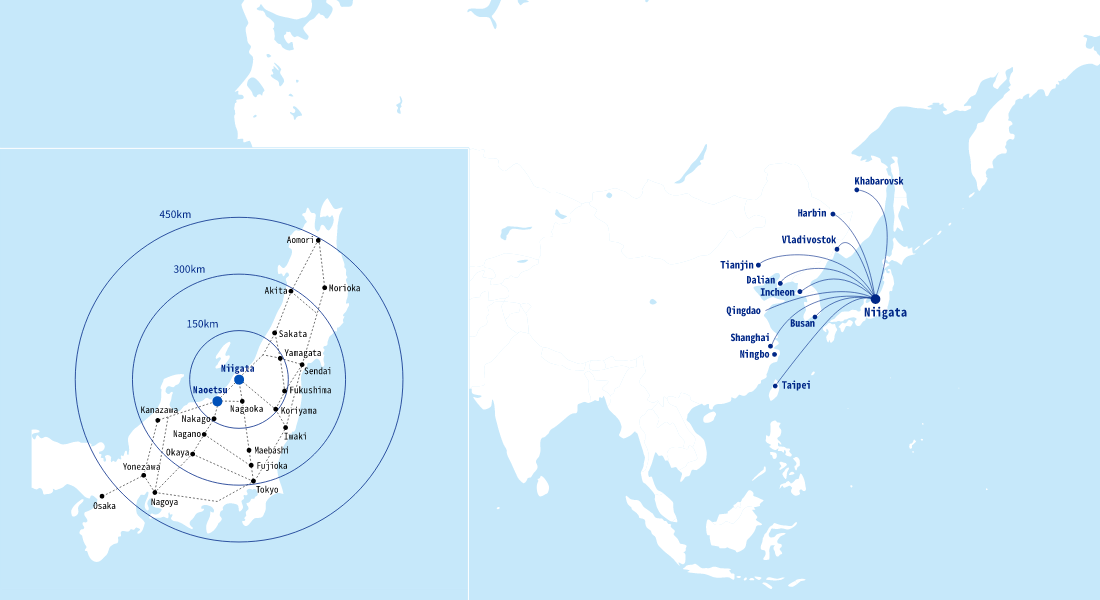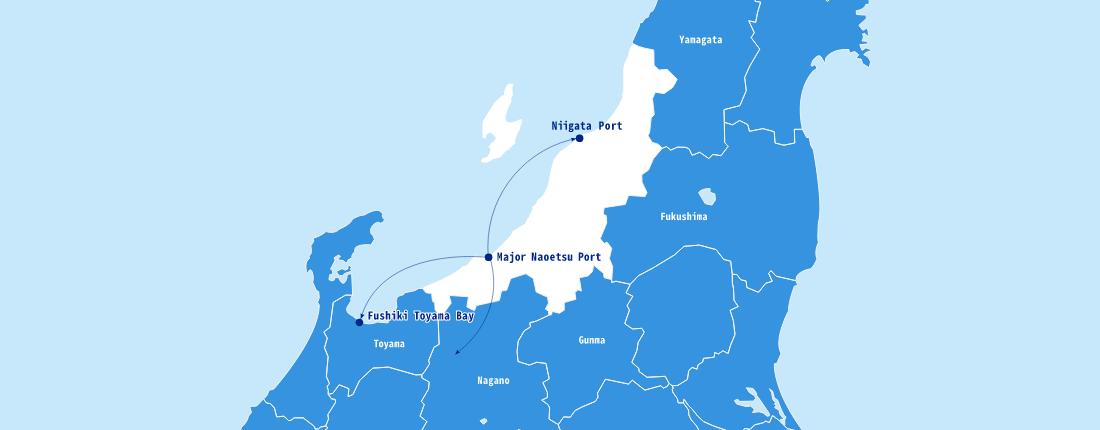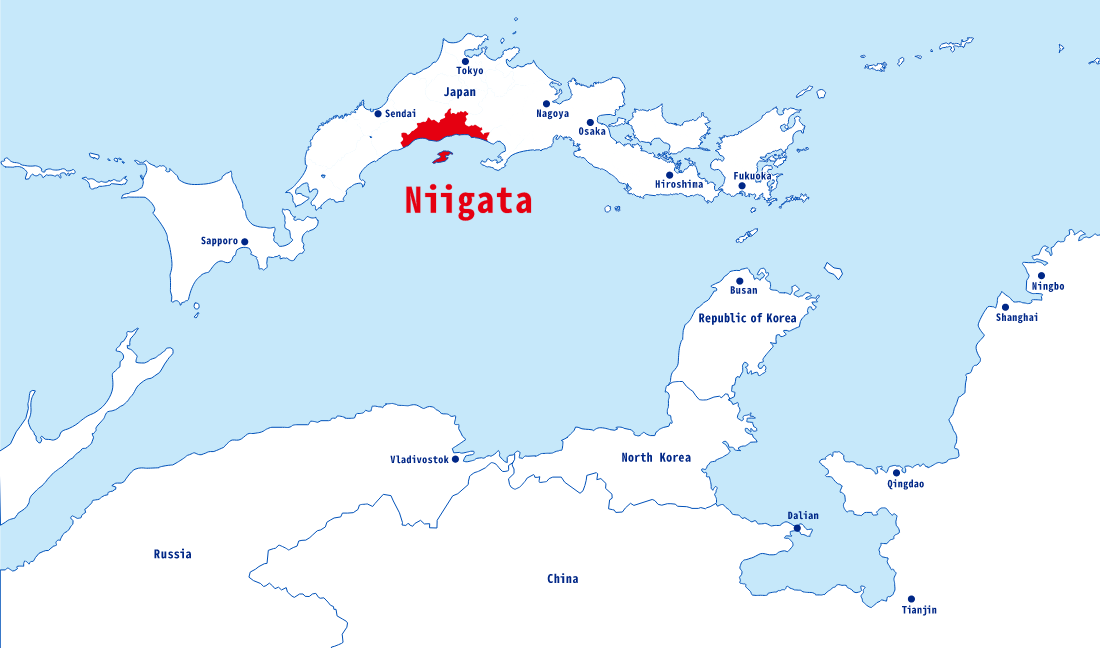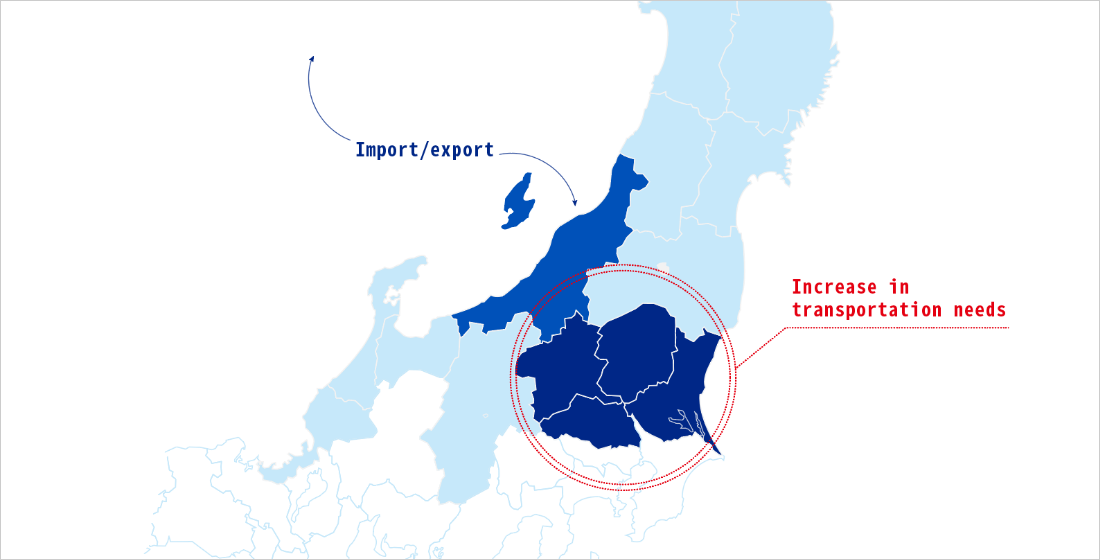Logistics Services at Niigata Prefecture Inner Port
- Service areas
- Bases
- Advantages of using Niigata Port
- Rinko’s work to improve the convenience of Niigata Port
- Regarding the basic action plan for alternative transportation via Niigata Prefecture Ports in the event of a large-scale disaster on the Pacific side
- Example
Service areas

There are eight regular international sailings a week from Niigata East Port, and regular international flights from Niigata Airport linking Niigata with China, South Korea, and Russia. In addition, we are able to implement logistics both in Asia and around the world through international cargo hubs such as the ports of Shanghai and Busan for marine transportation and Incheon Airport for air transportation.
Niigata is also conveniently located for prefectural highways and national expressways. Due to geographical factors such as Tokyo, Sendai, and Kanazawa being located within a 300 km range, it is also blessed as a base for domestic land transportation. Global logistics can be realized due to Niigata Port.
Bases
Rinko Wharf (Niigata West Port)

Rinko Wharf is the only privately owned port in Japan. We manage and operate port facilities. We are equipped with wharves capable of docking vessels up to 10m deep and up to 60,000 tons such as a general cargo wharf, a wharf dedicated to dangerous goods, and a wharf dedicated to oil tankers. In addition to commercial warehouses that store cargo unloaded from ships and cargo to be loaded, sheds, open storage yards, and fumigation facilities, we also have cargo handling machinery and vehicle equipment, including a large 90-ton crane for cargo handling. As a privately owned port, we are able to flexibly respond to the needs of our customers.
Niigata East Port

Niigata East Port, which has a vast industrial park and energy base behind the harbor and boasts the largest handling volume of foreign trade containers on the Sea of Japan side of mainland Japan, has steadily developed as a hub port in Northeast Asia since opening in 1969. In 2011, it was selected as a hub port on the Sea of Japan (comprehensive hub port and functional hub port for the international trade of container, LNG), and the role it plays is becoming more and more important. We offer a wide range of logistics services from mainboard and coastal cargo handling to storage and distribution processing with our extensive facilities such as terminal sheds, multi-level automated warehouses, and temperature-controlled warehouses.
Naoetsu Port

Located at the junction of the Joshinetsu and Hokuriku expressways, access has become even more convenient with the opening of the Hokuriku Bullet Train. We have regular container routes connecting Busan Port (South Korea), Dalian Port, and Tianjin Port (China), and we provide services around the world, including Asia, Europe, and the United States, with Busan Port as our hub port. In addition, the construction of an LNG thermal power plant is progressing, making it a developing port for the future. At Naoetsu Port, Himekawa Port, and Kashiwazaki Port, we are engaged in the shipping agency business, customs clearance, and intermediary business related to import and export cargo.
Latest movements
You can check the regular container ship schedule for Naoetsu Port here.
Access to each area from Naoetsu Port

Joetsu City, which has Naoetsu Port, is located almost in the center of the Sea of Japan coast and is a city where land and sea transportation networks intersect. The Hokuriku and the Joshinetsu expressways connect from Naoetsu Port to the rest of the main island, and several major railways (Myoko Haneuma Line, Nihonkai Hisui Line, Shinetsu Main Line, and Hokuhoku Line) connect too. With the opening of the Hokuriku Bullet Train at Joetsumyoko Station in March 2015, it has become a transportation hub for people and goods.
In addition, the Joshinetsu Expressway has been expanded to 4 lanes in all sections, and it fully opened in December 2019, improving access to Naoetsu Port.
Niigata Airport

Niigata Airport is conveniently located near the city center, about 25 minutes by bus from Niigata Station. In addition to regular overseas flights to Seoul, Shanghai, and Harbin, Niigata Airport also has regular domestic flights to Narita Airport, supporting import and export operations for the whole world. We provide total coverage for cargo collection and delivery for customers in Niigata and neighboring prefectures, customs clearance in bonded areas, sorting, packing, and storage.
Advantages of using Niigata Port
Geographical advantages of Niigata Port

Niigata Port is close to China, South Korea, and Russia across the Sea of Japan. Turn the map upside down. You can see that it’s a centrally located port in Japan for those areas. Also, the proximity of Niigata and the metropolitan area is obvious.
Since China, South Korea, and Russia have consulates located in Niigata City, exchanges of people, goods, and investments are frequent, deepening mutual understanding and establishing a track record. The major feature of Niigata Port is its superiority in being close to all these places in terms of economy and culture as well as geographical distance.
As a Backup for Ports on the Pacific Side of East Japan

Due to daily congestion, labor shortages, and traffic jams at the Ports of Tokyo, Yokohama, and Kawasaki, it may take several days for cargo to be delivered from the ship’s cargo handling to the warehouse. In Niigata Port, loading and unloading to the container yard is smooth. Since there are warehouses including dangerous goods warehouses in the harbor area, the movement can be completed in a short time, and the import and export customs declaration proceeds quickly. Thanks to these advantages, Niigata Port is attracting attention as a backup port for Keihin
Rinko’s work to improve the convenience of Niigata Port
Construction of the first full-scale warehouse for dangerous goods in the Niigata Port area

- Target cargo: Bonded Warehouse compliant with Dangerous Goods, Fire Service Law Category 4
- Total floor area: 990m2 One story (room temperature)
- Capacity: 4,800 drums (200 liters/drum)
Operations started in March 2019!
You can watch the video here.
Construction of two large-scale room-temperature warehouses

In order to increase storage capacity, we constructed two large-scale room-temperature warehouses.
- Terminal 8 (high floor), Terminal 9 (low floor)
- Terminal 10 (high floor)
- Floor area: 23,604m2
Operations started in September 2019!
Opened a warehouse for dangerous goods tank containers

- Items that can be stored: Fire Service Law Category 4: 2-4 (petroleum, animal and vegetable oils)
- Maximum storage capacity: 50 ISO tank containers
Regarding the basic action plan for alternative transportation via Niigata Prefecture Ports in the event of a large-scale disaster on the Pacific side
In response to the formulation of the Basic Action Plan for Alternative Transportation* for the ports of Niigata, Toyama, Ishikawa, and Fukui by the Hokuriku Region International Logistics Strategy Team (January 2017), we supplemented this plan and compiled a Niigata Prefecture version with additional content specific to this prefecture.
*”Basic action plan for alternative transportation via Hokuriku regional ports in the event of a large-scale disaster on the Pacific side”
Formulation: Wide Area Backup Subcommittee, Hokuriku Region International Logistics Strategy Team
(Secretariat: Hokuriku Regional Development Bureau, Ministry of Land, Infrastructure, Transport and Tourism)
Example
Transfer from other ports to Niigata Port
- Since the Toko Chemical Center Warehouse No. 1, which is capable of storing flammable liquids classified as Category 4 of the Fire Service Law and non-medicinal poisonous substances under the Poisonous and Deleterious Substances Law, has been in operation, chemical manufacturers in Niigata Prefecture that were using Keihin Port and surrounding warehouses are now shipping export cargo from Niigata Port.
- With easy access to main roads such as national highways and expressways, our warehouse located in the port area is used as a shipping and delivery base in northern Japan for both B2B and B2C.
- We have customers who use both ports on the Pacific side and Niigata Port to be prepared for the future. If there is a large-scale disaster on the Pacific side, they will be ready to immediately switch to using Niigata Port. Inquiries from shipping companies in Chukyo and Kansai, which are expected to experience a Nankai Trough earthquake, are also increasing.
- Niigata Port is used to avoid chronic congestion at Keihin Port and the constant shortage of trucks. We receive many orders for transportation services to the northern Kanto region because the difference in the number of sailing days can be covered by smooth cargo handling work at Niigata Port, customs procedures, and arrangement of collection and delivery vehicles.
- There are many routes that call at Niigata Port as a first port. Depending on the port of departure for import cargo delivered to eastern Japan including the Pacific Ocean, you can expect a lead time comparable to that of Keihin Port. Therefore, we are also entrusted with container transportation for neighboring prefectures and for Sendai City.
Contact
Inquiries by phone
Hours:9:00-17:00 (excluding weekends and holidays)
